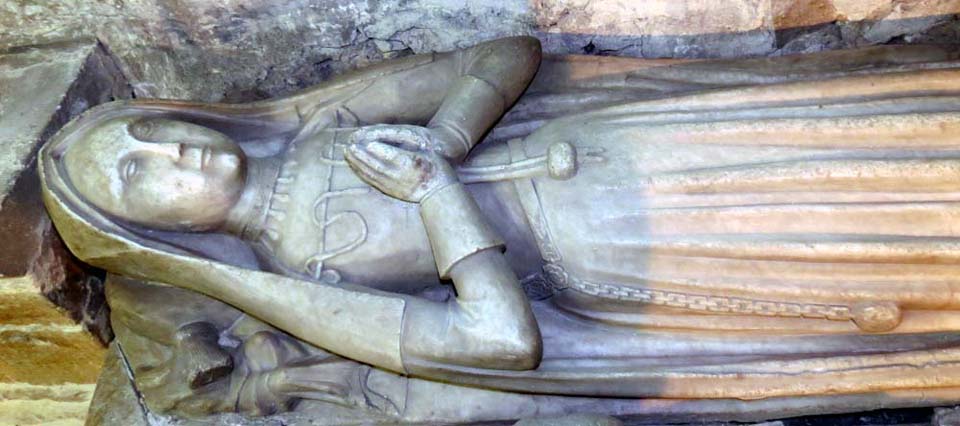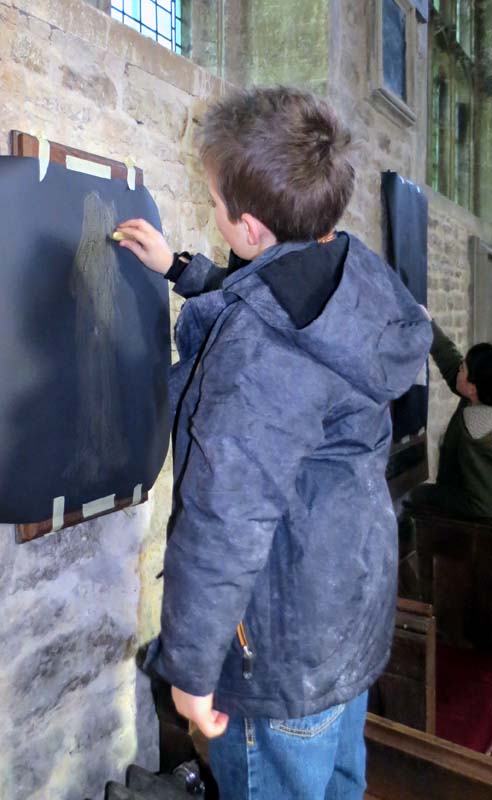Writing up my observations about the previous effigy was so rewarding, I think I’ll spend my Friday night analyzing another particularly fine sculpture.
This tomb, one of the first that I photographed, is located in Chipping Norton, Oxfordshire. It contains the figures of Richard Croft and his wife Agnes (or Anne), daughter of John Fox. Richard died in 1502 and requested “my body to be buryed in the Chapell of saint John Baptist in the Chirch of Chepingnorton by the walle on the left syde of said chapel ther where the Cofer standith.” His wife died in 1509.
The original monument lacked inscription (presumably the arms painted on the tomb were sufficient to identify it); one was added in 1683 by a descendant of the Croft family. Although the tomb likely stands near its original location in the church, it has clearly been disassembled, patched, and probably incorrectly reassembled. The head of the tomb has two niches from which the figures have been lost:
The decorative architectural elements around these niches appear to match those around two mourners on the side of the tomb as if they, and not the the shield-bearing angels, belong on the side of the tomb.
Richard and Agnes Croft had four children – two sons, two daughters – and because the mourners on the side of the tomb appear to be one male, one female, I think that the sides of the tomb have been reassembled out of order. The empty niches probably stood where the angels are now with praying figures representing their eldest daughter and son. The angels most likely graced the head of the tomb. I have no idea what was originally at the foot, for now the limestone slab with the 1683 inscription is there.
Agnes’s clothing is similar to that of Edith Babington. I am pleased to find such costume in 1502, during the lifetime of Elizabeth of York, substantiating the idea that the fashion the queen adopted had been embraced by contemporary ladies. Like Edith, Agnes wears round-toed shoes, a full-length gown, a loose belt with an off-center pendant on a square chain, a gabled headdress, and a full-length mantle just covering her shoulders that is held with a cord decoratively looped over her chest. Not only is no closure evident on the gown, but I detect no neckline; I assume that it is meant to be behind the cord.
Some features of Agnes’s clothes differ from Edith’s. Each sleeve ends in a large turned back cuff. Her hood, while similar, has fewer visible layers. Over the peaked under-cap she has a frontlet that drapes down her arms. Behind this is another layer of fabric that I cannot interpret well. The back of the cap is an interesting mix of curves and angles. If only I could see what is obscured against the pillow! The fold in the frontlet over her temple has a strong upward angle as it moves away from the face. This is unusual; on that part of the hat I usually see something close to a right angle fold running parallel to the ground.
Agnes’s belt is similar to Edith’s, with a rose clasp and a pendant, likely a pomander:
The belt clearly illustrates the form of the clasp: a rose with two hooks off the back. Each hook fits into a hole on the end of her belt, which was probably leather and possibly also fitted with metal chapes at each end. Why did Edith wear her belt on the left hip, while Agnes wears hers on the right? I prefer dangling items on my left (non-dominant) side, and during this time being left handed was fiercely discouraged. Perhaps this figure was always meant to rest against the wall, so the belt was carved on the outward facing side where it could be admired.
The greatest difference between these effigies is Agnes’s jewelry. The necklace seems outdated compared to the rest of her costume. Wide, ornate collars usually grace effigies with hat styles of the late 15th century, such as butterfly headdresses and truncated hennins. Since Agnes was most likely alive when this effigy was carved, perhaps she specified the items of dress in which she was depicted. Although I know tombs were usually created without any attempt to accurately depict the people they represented, I’d like to imagine that she had a favorite necklace and requested a version of it carved on her effigy.
This tomb was a delight to see, although I am annoyed with myself for failing to take detailed photographs of certain sides and angles. I was just learning how to photograph effigies when I visited.
My entire family accompanied me on the excursion to Chipping Norton. It was supposed to be a short stop on our way to Stratford-upon-Avon, but we ended up spending most of our short winter daylight hours in town (minus those spent stuck in traffic around Oxford). My older boys each made a brass rubbing while my husband entertained the littlest one in the church’s nursery corner.
The church is large and quite beautiful, with a stunning clerestory that streams sunlight into the nave. While we were inside a church warden happened upon us and was amazed that someone would come all the way from America to see the tombs in his church. Chipping Norton is not a tiny town, but it isn’t a standard tourist destination, either. He loves the tombs (there is also an Elizabethan one) and wishes his church could pay for a restoration. He showed me a recent conservation report and asked that I let him know if I learned anything about these people or this tomb. I hope someday I can provide him with a bit of interesting information.











“The belt clearly illustrates the form of the clasp: a rose with two hooks off the back. Each hook fits into a hole on the end of her belt, which was probably leather and possibly also fitted with metal chapes at each end. “
Something Dr. Jane M-D (or was it Ninya?), anyway one of them mentioned during their workshops that the ladies in the wills that they researched do not have leather belts, they have fabric girdles. I plan on having one made for my outfit, and really appreciate your rose detail above. Thanks again!
Oh! Interesting. The teacher in the leather sewing class thought women wore leather belts in this time period, so I hadn’t stopped to think hard about it. But fabric is also perfectly believable, especially since something draped like that wouldn’t be under great stress.